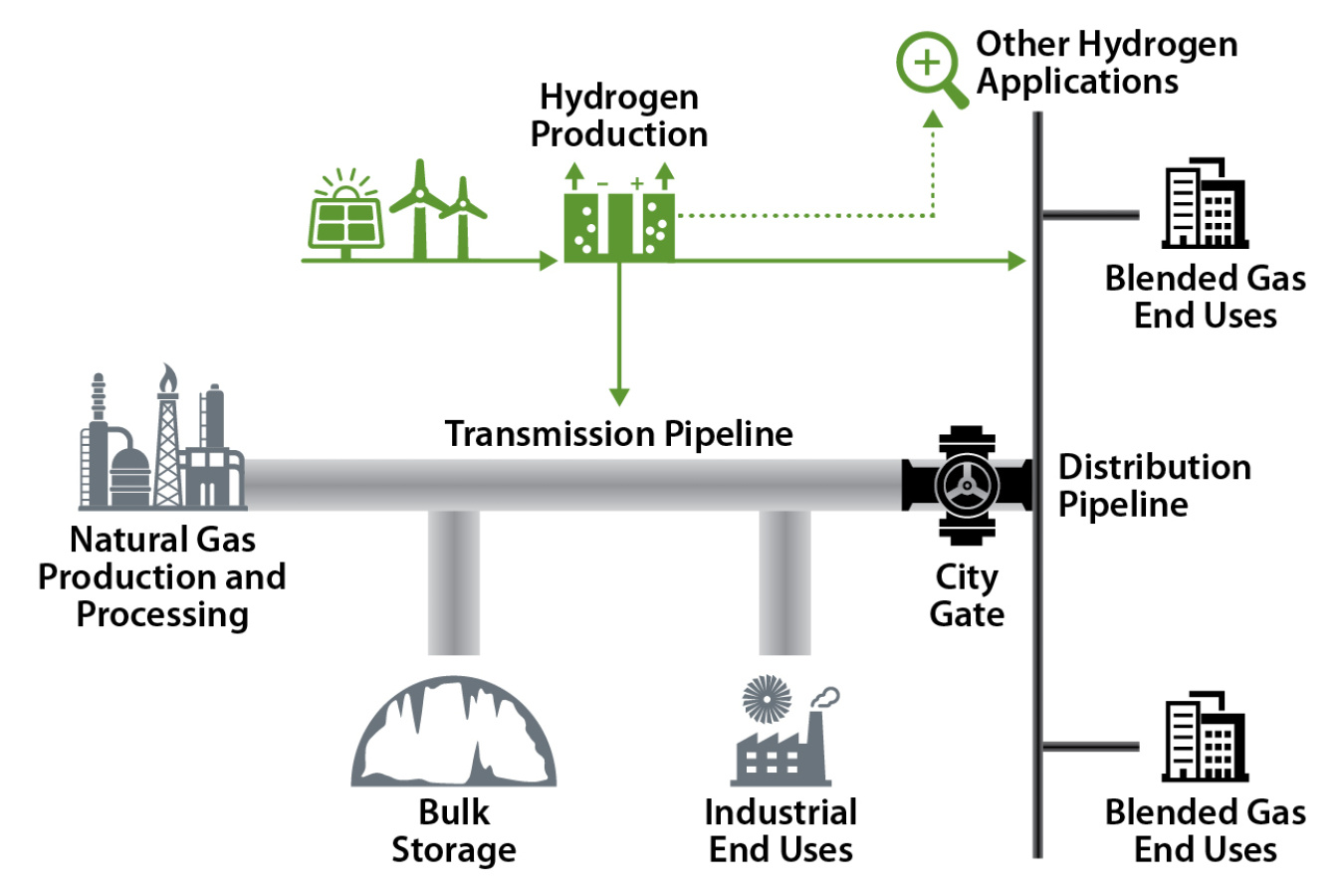
The HyBlend initiative aims to address technical barriers to blending hydrogen in natural gas pipelines. Key aspects of HyBlend include materials compatibility R&D, techno-economic analysis, and life cycle analysis that will inform the development of publicly accessible tools that characterize the opportunities, costs, and risks of blending. This effort supports DOE's H2@Scale vision for hydrogen use across multiple sectors in the economy.
Overview

The United States has an extensive network of approximately three million miles of natural gas pipelines and more than 1,600 miles of dedicated hydrogen pipeline. Hydrogen produced through affordable pathways can be injected into natural gas pipelines, and the resulting blends can be used to generate heat and power with lower environmental impacts compared to natural gas alone.
Blend limits depend on the design and condition of current pipeline materials, of pipeline infrastructure equipment, and of applications that utilize natural gas. The HyBlend team will test pipeline materials in varying concentrations of hydrogen at pressures up to 100 bar to assess their susceptibility to hydrogen effects.
Organization
DOE launched the HyBlend collaboration in 2021 and coordinates related work through the Hydrogen Program. R&D projects within the collaboration are primarily being conducted by the National Laboratory team—led by the National Renewable Energy Laboratory (NREL) with support from Argonne National Laboratory (ANL), Pacific Northwest National Laboratory (PNNL), and Sandia National Laboratories (SNL)—with the participation of more than 30 partners in industry, nonprofits, and academia. DOE’s Hydrogen Program coordinates RD&D across DOE offices and with other government agencies, such as the U.S. Department of Transportation’s Pipeline and Hazardous Materials Safety Administration. The Pipeline Blending Cooperative Research and Development Agreement project is coordinated through the Pipeline Research Council International.
Curated Research Tools
Blending Pipeline Analysis Tool for Hydrogen (BlendPATH), an open-source program to assess the system impacts and costs of repurposing existing pipelines for hydrogen and hydrogen blends.
Hydrogen Extremely Low Probability of Rupture (HELPR), an open-source software for assessing structural integrity of pipelines for hydrogen and hydrogen blends.
Outreach
BlendPATH Webinar, Webinar led by NREL (2024)
October H2IQ Hour: HyBlend Initiative, DOE H2IQ Webinar led by all labs (2023)
Design and Operation of Metallic Pipelines for Service in Hydrogen and Blends, Webinar led by SNL (2022)
Key Publications
Blending Pipeline Analysis Tool for Hydrogen (BlendPATH) Documentation and User Manual, NREL Technical Report (2025)
Blending Low-Carbon Hydrogen with Natural Gas: Impact on Energy and Life Cycle Emissions in Natural Gas Pipelines, Gas Science and Engineering (2024)
Gap Analysis on the Impacts of Hydrogen Addition to the North American Natural Gas Infrastructure Polyethylene Pipelines, PNNL Technical Report (2022)
Utilizing Probabilistic Analyses to Explore Performance Margins of Natural Gas Infrastructure for the Transport and Delivery of Hydrogen and Hydrogen Blends, Proceedings of the ASME 2024 Pressure Vessels & Piping Conference (2024)
Hydrogen Pressure Cycling of Subscale Pipes to Simulate Full-Scale Testing of Transmission Pipelines, Proceedings of the 2024 15th International Pipeline Conference (2024)
Influence of Hardness on Hydrogen-Assisted Fracture in Pipeline Steels, Proceedings of the 2024 15th International Pipeline Conference (2024)
Techno-Economic and Life Cycle Analysis of Synthetic Natural Gas Production from Low-Carbon H2 and Point-Source or Atmospheric CO2 in the United States, Journal of CO2 Utilization (2024)
Comparison Between Fatigue and Fracture Behavior of Pipeline Steels in Pure and Blended Hydrogen at Different Pressures, Proceedings of the ASME 2024 Pressure Vessels & Piping Conference (2024)
In-Situ and Ex-Situ Studies on the Morphology Changes of Polymer Pipeline Materials for Use in Hydrogen Gas Environments, Proceedings of the ASME 2024 Pressure Vessels & Piping Conference (2024)
Investigating In-Situ Fracture Behaviors of Polymer Pipeline Materials in Hydrogen and Hydrogen-Methane Blended Gas Environments, Proceedings of the ASME 2024 Pressure Vessels & Piping Conference (2024)
HyBlend: Pipeline Blending Cost and Emissions Analysis, NREL Presentation (2024)
Hydrogen Blending into Natural Gas Pipeline Infrastructure: Review of the State of Technology, NREL Technical Report (2022)

